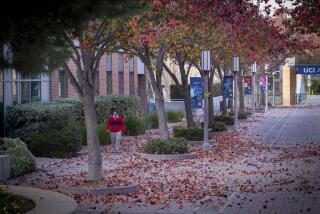Quick Orange County Reactions : UC Study Shows Cutback of Animal Use in Research
University of California researchers, aided by new technological alternatives, have cut back sharply in the last few years on their use of animals for experimentation, a report prepared by the university said Friday.
The study, which had been ordered by the state Legislature, said that although scientists have become less dependent on animals, there may never come a time when animals will not be sacrificed in the the study of disease.
The report was immediately criticized by the leader of an Orange County animal rights group that has protested use of lab animals in UC Irvine experiments. And the study was hailed by UCI’s research director.
The report, released Friday, said 469,394 animals were used in California experiments in the 1986-87 fiscal year, 80% of them rats and mice.
That represented a sharp decline from the more than 600,000 animals used in research projects during the 1982-83 fiscal year, the report noted. But while the total number of animals used declined, the percentage of larger animals used--dogs, cats, primates, sheep, pigs or goats--remained at 2% to 3%.
The report said many new methods of research had been developed over the past decade to reduce the number of animals used in medical experiments, including sophisticated cell culture techniques, computers and advanced imaging technologies.
It further noted that UC Berkeley’s School of Public Health had reduced the number of mice it uses each year from 25,000 in the early 1960s to 100 to 200 today.
The report, which comes at a time of increasing activism by animal rights groups, defended the way in which research was conducted on university campuses and said scientists were almost universal in their desire to find alternative methods of experimentation.
Whenever possible, it said these alternatives were used to avoid killing the tens of thousands of rodents, pigs, primates, dogs and cats used each year in California scientific research.
Prepared by a committee of 16 scientists from the UC, Stanford, Caltech and USC, the report looked at the current state of animal research within the university system and found it fundamentally sound.
Some of its conclusions:
- That there are incentives and pressures in favor of selecting and using alternative methods of non-animal models in research.
- That it is through animal research that some alternatives are developed and applied.
- That animals are used only when they provide an effective and efficient way to address a research problem and when there are no suitable alternatives available.
- That even though the number of animals used in experiments has dropped considerably in the last decade, animal models will continue to be used because alternate sources simply do not exist.
The report also found that university medical centers take precautions to make sure that animals are not needlessly killed and that when they are sacrificed, it is done in a humane way.
“I think that among the most important conclusions is that there are incentives and pressures in favor of using these alternative methods in research,” said Belle Cole, UC’s director of public policy. “We believe that the system we have in place is a good one.”
But the the report drew immediate fire from animal rights activists, who believe that experiments with live animals is morally wrong and scientifically fraudulent.
“So what else is new?” said Judy Stricker, head of the Society Against Vivisection, a national group with headquarters in Costa Mesa.
“It’s the same old (nonsense). They do not cure a darn thing. All they do is mask the symptoms and produce more problems. We don’t even have a cure for the common cold. We keep dying like flies out here. This health system we have in this country is a big joke. They have been conducting studies forever. This is just another study.”
One militant group, which calls itself the Animal Liberation Front, has targeted UC Irvine to protest the use of dogs in research on smog and sleep disorders. Thirteen beagles were recently stolen from the facility, and the group has threatened to strike again at other California research facilities.
Prof. Robert F. Phalen, who was directing the UC Irvine research, Friday welcomed the report as a vindication of his research.
“The biomedical community has always been strongly in favor of using alternatives when available,” he said. “The animal rights people attempt to paint the research community as greedy, and it simply isn’t fair.”
Phalen said in his research there is no alternative to the use of live animals.
The report agreed that in some cases, there was no substitute for live animals. It cited research into acquired immune deficiency syndrome as an example.
“Animal models and cell and tissue culture studies have played important roles” in AIDS research, the report said.
Ultimately, it added, any type of AIDS vaccine or drugs “must be tested in animal models to minimize the dangers to which humans might otherwise be exposed.”
Responding to concerns that not enough thought was given before animals were used in scientific experiments, the report noted that a campus review system required by federal and institutional law included proper incentives and pressures favoring the use of alternative methods in research. It said each experiment involving animals was scrutinized to make sure the research was necessary.
“Every university campus has an animal care committee, and it reviews the research proposals, and they ask the question: Do you need to use these animals, do you need to use this number of animals?” Cole said.
The report concluded that there was no need to modify the present campus review system to encourage the use of alternatives.
In stressing that animals are absolutely necessary in some instances, a UC spokesman indicated that the steady decline in the number of animals may be leveling off.
“You can’t get down to a point where none are used,” spokesman Paul West said. “They’re not sure how much farther they can take it.”
The report concluded that the “use of live animals will continue to be necessary in the biomedical and behavioral sciences” and added: “Alternative models that completely describe the complexity of organ systems and the interactions that take place in living systems do not exist. Also, animals are needed in procedures to obtain alternative models.”
Cole noted that it was research on animals that led to many of the alternative methods, and that using them together was equally important.
“They are used together, interdependently,” she said. “There may never be a time when we won’t need them (animals).”






